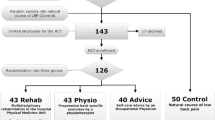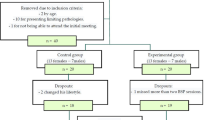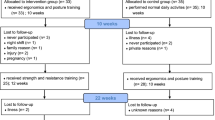Abstract
Back schools are increasingly utilized as an injury prevention strategy employed at the worksite. Yet, evidence of the efficacy of back schools is limited and controversial. A review of the literature showed variance in methodologies and consequently, outcomes. Outcome measures used include physical capacity, functional abilities, costs, lost time, absenteeism, perception of pain, lifting performance, attitudes, and job satisfaction. In many studies, lack of randomization and control was found to be a limitation in experimental design. Studies which used the behavioral approach of measuring lifting behavior lacked followup and evidence of long-term effects. The type of education and feedback or reinforcement was an important issue not well-defined in the literature. A variety of hypothetical mechanisms were described as contributing to the outcome of back injury prevention programs. Additional controlled research is necessary to determine the specific mechanisms of change in an effort to further improve outcome in this area.
Similar content being viewed by others
References
Andersson GB, Pope MH, Frymoyer JW. Epidemiology. In: Pope MH, Frymoyer JW, Andersson GB, eds.Occupational low back pain. New York: Prager Publishers, 1984, pp. 104–114.
Deede B, McGovern P. Low back problems: Etiology and prevention.Am Assoc Occup Health Nursing 1987; 35: 341–348.
White AA, Gordon SL. Synopsis: Workshop on idiopathic low back pain.Spine 1982; 7: 141–149.
Burton JF, ed.Worker's Compensation Monitor. Quoted inThe Wall Street Journal May 24, 1991.
Burton CV, Cassidy JD. Economics, epidemiology, and risk factors. In: Kirkaldy-Willis WH, Burton CV, eds.Managing low back pain. New York: Churchill Livingstone, 1992, pp. 1–6.
Frymoyer JW, Pope MH, Clements JH, Wilder DG, MacPherson B, Shikaga T. Risk factors in low-back pain: An epidemiological survey.J Bone Joint Surg 1983; 65: 213–218.
Biering-Sorensen F. Physical measurements as risk indicators for low-back trouble over a one-year period.Spine 1984; 9: 106–119.
Snook SH. Low back pain in industry. In: White AA, Gordin SL, eds.American academy of orthopaedic surgeons symposium on idiopathic low back pain. St. Louis: C. V. Mosby, 1982, pp. 87–95.
Domkot DK, Pope MH, Lord J, Frymoyer JW. The relationship between work history, work environment, and low-back pain in men.Spine 1984; 9: 395–399.
Kelsey JL, Githens PB, White AA. An epidemiologic study of lifting and twisting on the job and risk for acute prolapsed lumbar intervertebral disc.J Orthopaedic Res 1980; 2: 61–66.
Andersson GJ, Svensson H, Oden A. The intensity of work recovery in low back pain.Spine 1983; 8: 880–884.
Frymoyer JW, Rosen JC, Clements J, Pope MH. Psychologic factors in low-back pain disability.Clin Orthopaedics 1985; 195: 178–184.
Sirles AT, Brown K, Hilyer JC. Effects of back school education and exercise in back injured municipal workers.Am Assoc Occup Health Nursing 1991; 39: 7–12.
United States Department of Health and Human Services.Draft objectives for the year 2000. Washington, D.C.: U.S. Public Health Service, 1989.
Brown KC, Sirles AT, Hilyer JC, Thomas MJ. Cost-effectiveness of a back school intervention for municipal employees.Spine 1992; 17: 1224–1228.
Zachrisson-Forssell M. The back school.Spine 1981; 6: 104–106.
Hall H, Iceton J. Back school: An overview with specific references to the Canadian back education units.Clin Orthopaedics Related Res 1983; 179: 10–17.
Hurri H. The Swedish back school in chronic low back pain. Part 1: Benefits.Scan J Rehab Med 1989; 21: 33–40.
Nordin M, Cedraschi C, Balague F, Roux E. Back schools in prevention of chronicity.Bailliere's Clin Rheum 1992; 6: 685–702.
Snook SH. Approaches to the control of back pain in industry: Job design, job placement, and education/training.Occup Med 1988; 3: 45–59.
Martin L. Back basics: General information for back school participants.Occup Med 1992; 7: 9–16.
Mattmiller AW. The California back school.Physiotherapy 1980; 66: 118–121.
Bergquist M, Larsson U. Acute low back pain in industry: A controlled prospective study with special reference to therapy and confounding factors.Acta Orthopaedica Scan Suppl 1977; 170: 97–110.
Hurri H. The Swedish back school in chronic low back pain. Part II: Factors predicting the outcome.Scan J Rehab Med 1989; 21: 41–44.
Donchin M, Woolf O, Kaplan L, Floman Y. Secondary prevention of low back pain: A clinical trial.Spine 1990; 15: 1317–1320.
Kvien T, Nilsen H, Vik P. Education and self-care of patients with low back pain.Scan J Rheum 1981; 10: 318–320.
Klaber-Moffett JE, Chase S, Portek I, Ennis J. A controlled, prospective study to evaluate the effectiveness of a back school in the relief of chronic low back pain.Spine 1986; 11: 120–122.
Aberg J. Evaluation of an advanced back pain rehabilitation program.Spine 1984; 9: 317–318.
Berwick D, Budman S, Feldstein M. No clinical effect of back schools in an HMO.Spine 1989; 14: 338–344.
Dehlin O, Berg S, Andersson G, Grimby G. Effect of physical training and ergonomic counselling on the psychological perception of work and on the subjective assessment of low-back insufficiency.Scan J Rehab Med 1981; 13: 1–9.
Lankhorst GJ, VandeStadt RJ, Vogelaar TW, VanderKorst JK, Prevo AJ. The effect of the Swedish back school in chronic idiopathic low back pain.Scan J Rehab Med 1983; 15: 141–145.
Walsh, NE, Schwartz RK. The influence of prophylactic orthoses on abdominal strength and low back injury in the workplace.Am J Phys Med Rehab 1990; 69: 245–250.
Ryden AL, Molgaard CA, Bobbitt SL. Benefits of a back care and light duty health promotion program in a hospital setting.J Community Health 1988; 13: 222–230.
Fitzler SL. Attitudinal change: The Chelsea back program.Occup Health Safety 1982; 24–27.
Fitzler SL. Chelsea back program: One year later.Occup Health Safety 1983; 52–54.
Snook SH, Campanelli RA, Hart JW. A study of three preventive approaches to low back injury.J Occup Med 1978; 20: 478–481.
McElligott J, Miscovich SS, Fielding L. Low back injury in industry: The value of a recovery program.Connecticut Med 1989; 53: 711–915.
Versloot JM, Rozeman MA, vanSon AM, vanAkerveeken PF. The cost—effectiveness of a back school program in industry.Spine 1992; 17: 22–27.
Lepore BA, Olson CN, Tomer GM. The dollars and sense of occupational back injury prevention training.Clin Management 1984; 4: 38–44.
Mantle M, Holmes J, Currey H. Backache in pregnancy II: Prophylactic influence of back care classes.Rheum Rehab 1981; 20: 227–232.
Wood D. Design and evaluation of a back injury prevention program within a geriatric hospital.Spine 1987; 12: 77–82.
Feldstein A, Valanis B. Vollmer W, Stevens N, Overton C. The back injury prevention project pilot study.J Occup Med 1993; 35: 114–120.
Komacki J, Barwick K, Scott L. A behavioral approach to occupational safety: Pinpointing and reinforcing safe performance in a food manufacturing plant.J Appl Psych 1978; 63: 434–445.
Komacki J, Heinzmann AT, Lawson L. Effect of training and feedback: Component analysis of a behavioral safety program.J Appl Psych 1980; 65: 261–270.
Chaffin D, Gallay L, Woolley C, Kuciemba S. An evaluation of the effect of a training program on worker lifting postures.Int J Indus Ergonomics 1986; 1: 127–136.
Wollenberg SP. A comparison of body mechanic usage in employees participating in three back injury prevention programmes.Int J Nursing Stud 1989; 26: 43–52.
Carlton RS. The effects of body mechanics instruction on work performance.Am J Occup Ther 1987; 41: 16–20.
St. Vincent M, Tellier C. Training in handling: An evaluative study.Ergonomics 1989; 32: 191–210.
Author information
Authors and Affiliations
Rights and permissions
About this article
Cite this article
King, P.M. Back injury prevention programs: A critical review of the literature. J Occup Rehab 3, 145–158 (1993). https://doi.org/10.1007/BF01078284
Issue Date:
DOI: https://doi.org/10.1007/BF01078284




